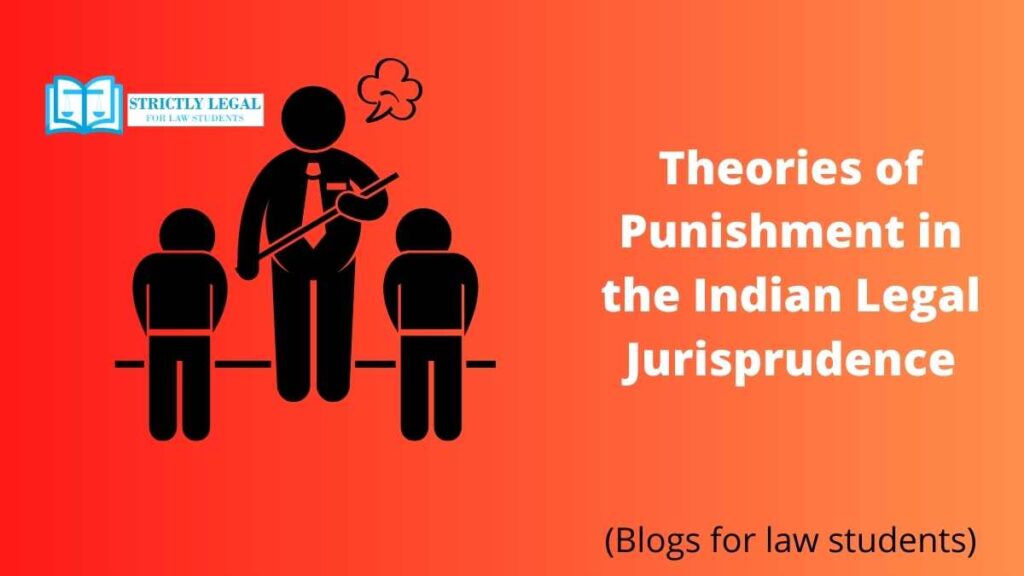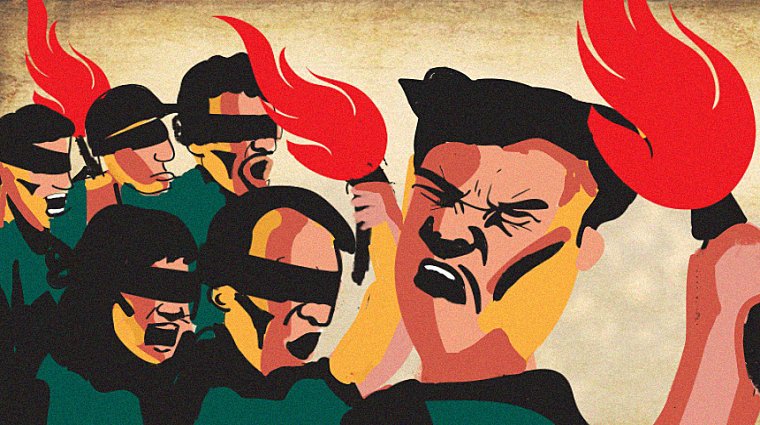The Indian Legal Jurisprudence has come a long way in evolving its way of punishment for offences. From the peculiar feature of Hindu legal system to punish according to one’s caste or social position to the rules of Mughal and then eventually adapting to the English model through the British, we now have a much more liberal system in a sense they are less likely to be inhumane.
Various theories of punishment are advanced in justification for punishing the offenders. The Perspective regarding punishment also kept on changing with the changes in societal norms. They have been reflected in the form of different theories. This article discusses a few theories of punishment and evaluates their effective usages in the modern India.
Table of Contents
Deterrent Theory
The main object of punishment is to make the commission of an offence an ill bargain for the offender and push away others from committing the crimes. As Salmond rightly puts it, punishment is before all things deterrent and the chief aim of the law of crime is to make the evil-doer an example and a warning to all that are like-minded with him. Considered from this point of view punishment is a means of attaining social security as it seeks to protect the society by deterring potential offenders.
Salmond asserted that offences are committed by reason of conflict of interests of the offender and the society. Punishment prevents such offences by destroying the conflict of interests by making acts that are injurious to others as injurious to the doer himself. This end of criminal justice is achieved by inflicting severe punishment on the offenders. The general deterrence theory of punishment, therefore, justifies exemplary punishment because it not only dissuades the offender from repeating the crime but also deters others from indulging in such criminal activities. G.W. Paton also supported this view and observed that deterrent theory emphasises the necessity of protecting society by treating offenders in a manner so that others are deterred from law-breaking.
It is significant to note that deterrent theory of punishment was supported by Manu, the great law-commentator of ancient India. He treated punishment or danda, as the source of righteousness because people are refrained from committing wrongful acts through the fear of punishment. Most penal systems made use of deterrent theory as the basis of their sentencing mechanism till early nineteenth century. Particularly in the case of England, punishments were more severe and barbaric in nature.
In India also inhuman punishment such as mutilation, beheading, flogging branding else was in vogue till the end of the eighteenth century The advocates of deterrent punishment hold that fear in the mind of the perpetrator of the crime and the consequences that could befall on him dissuades him from committing the crime.
Justice Holmes opposed this theory of punishment on the ground that it was immoral inasmuch as it lays down no definite measure of punishment except the subjective opinion of the Judge.
The critics of the deterrent theory of punishment argue that it has proved to be ineffective in restricting crimes. Even during the reign of Queen Elizabeth who was a staunch supporter of deterrent theory and awarded the severest punishment to smallest offences such as pick-pocketing, offences were rampant and pickpockets were seen busy in their criminal activity among the crowds which gathered to watch the execution of condemned pickpocket.
This indicates the futility of deterrent theory of punishment. Undoubtedly, the rigour of deterrent punishment acts as a sufficient warning to the offenders and also to others but it invariably fails in case of hardened criminals. The ineffectiveness of deterrent punishment is further evinced by the fact that quite a large number of hardened criminals return to prison sentences soon after their release. They seem so much used to prison life that they have lost all interest in leading a normal life in society. Thus the object underlying deterrent is unquestionably defeated It must, however, be added that despite being harsh and cruel in nature, deterrence as an end of punishment has not been completely eliminated from the modem sentencing models.
It may be justifiable when the offence is deliberate, pre-planned, and barbaric and a menace to the safety and security of the society. Particularly, in cases of anti-national conspiracies, communal violence, and multiple murders, deterrent punishment would meet the needs of justice.
Retributive Theory
In primitive societies punishment was mainly retributive. It was regarded as an end in itself. According to this theory, evil should be returned for evil without any regard to consequence. The theory is based on the rule of natural justice which is expressed by the maxim an eye for an eye and a tooth for a tooth The theory therefore, emphasises that the pain to be inflicted on the offender by way of punishment must outweigh the pleasure derived by him from his criminal act. Thus the retributive theory suggests that punishment is an expression of society’s disapprobation for the offender’s criminal act.
It has been rightly pointed out by Sir Walter Moberly that the drama of wrong doing and its retribution has indeed been an unending fascination for the human mind. He further suggests that retributive punishment serves to express and satisfy the righteous indignation with which a healthy-minded community regards transgression as antisocial behavior.
It is however questionable whether retribution can be justified on the ground of social policy. The theory of retribution owes its origin in the crude animal instinct of individual or group to retaliate when hurt and therefore, its approach to offender is vindictive and out of tune with the modern reformative concept of punishment
Those who support retributive theory claim that punishment is the appropriate moral response to criminal acts because the perpetrators of crime deserve to be punished. On this issue, it shares a common view with deterrence theory which also defends punishment as morally just and that the severity of the punishment inflicted upon the offender should be in proposition to the gravity of the crime for which he has been found guilty.
The retributivists, therefore, harp upon infliction of bodily pain and suffering, imprisonment, deportation and even the death sentence which renders the theory irrational, revengeful, and unjustifiably barbaric.
Closely connected with the idea of retribution is the notion of expiation which means blotting out the guilt by suffering an appropriate punishment. This in other words means that guilt plus punishment is equal to innocence. The philosophy underlying expiatory theory is that to suffer punishment is to pay debt due to the law that has been violated. As Salmond rightly puts it. “revenge is the right of the injured person. The penalty of wrong-doing is a debt which the offender owes to his victim, and when the punishment has been endured, the debt is paid, the liability extinguished,innocence is substituted for guilt, and the vinculum juris forged by crime is dissolved.
The object of true redress is to substitute justice for injustice. The practical utility of the expiatory theory cannot be undermined as it is an expression of refinement and purification of the criminal by self-motivation which ultimately gives him the satisfaction that his guilt has been washed off and he is relegated to a position if he had done no wrong. Expiation in the form of penance occupied an important place in the ancient Indian penology.
Preventive Theory
The preventive theory is founded on the idea of preventing repetition of crime by disabling the offender through measures such as imprisonment, forfeiture, death punishment, suspension of licences etc. G.W. Paton suggests that preventive theory seeks to prevent the prisoner from committing crime by disabling him.
This theory does not lay much emphasis on the motive of the wrongdoer but seeks to take away his physical power to commit the offence. It presupposes that the need for punishment for crime arises simply out of social necessities. In punishing a criminal, the community protects itself against anti-social acts that endanger social order in general.
Commenting on preventive theory of punishment, Fichte observed, “the end of all penal laws is that they are not to be applied. Thus when a landowner puts a notice “trespassers will be prosecuted”, he does not want an actual trespasser and to have the trouble and expense of setting the law in motion against him. He hopes that the threat will render any such action unnecessary, his aim is not to punish for trespass but to prevent it. However, if trespass still takes place, he shall undertake prosecution of the trespasser. Thus the real object of the penal law is to make the threat generally known rather than putting it occasionally into execution.
This indeed makes the preventive theory realistic and humane. It is effective for discouraging anti-social conduct and a better alternative to deterrence or retribution which now stand more or less discarded as methods of dealing with crime and criminals.”
In England, the preventive theory was supported by utilitarian law- reformers because of its humanizing influence on penal law. In their view, it is the certainty of law and its severity which has a real effect on offenders. The development of the institution of prison is essentially an outcome of the preventive theory of crime. It presupposes some kind of physical restraint on the defenders. According to this theory, murderers are sometimes given death penalty not merely to deter others from meeting similar end but to eliminate such dreadful offenders from society.
The preventive theory has been criticised by Kant and others who argue that merely by awarding a term of Imprisonment and sending the offender to jail is not going to reduce crime unless some reformative efforts are made to integrate him in the mainstream of the society through the process of rehabilitation.
Expiatory Theory
As a matter of fact, the expiatory theory of punishment being solely based on morality has little to do with law or legal jurisprudential concepts. Therefore, many jurists refuse to accept it as a legal theory of punishment. This theory is more related to ancient religious perceptions regarding crime and punishment when prisoners were placed in cells to repent or expiate for their crime or guilt from the core of their heart and resolve to shun crime. It was believed that anyone who sincerely repents for his misdeeds or crimes, deserves that among who sincerely represents for his misdeeds or crimes, deserves to be forgiven and let off.
The ancient Hindu law commentator Manu was a great admirer expiation as a form of punishment for the rehabilitation of the criminal in the society.
The expiatory theory, being based on ethical considerations, has lost its relevance in the modern system of punishment in the present age of materialism and declining moral values, expiation can hardly be effective in bringing about a change in the criminal mentality of offenders and therefore, expiatory theory as a punishment is not suited in the present context of rationalized penal policies.
Reformative Theory
The reformative theory of punishment emphasizes on the reformation of offenders through the method of individualization. It is based on the humanistic principle that even if an offender commits a crime, he does not cease to be a human being. Therefore, an effort should be made to reform him during the period of his incarceration. While awarding the punishment, the Judge must take into consideration the age and character of the offender, his antecedents, and also the circumstances under which he committed the criminal act.
Thus as opposed to deterrent theory, the reformative theory aims at socialization of the offender so that the factors which motivated him to commit the crime are eliminated and he gets a chance of leading a normal life in the society.
The theory is based on the principle, hate the sin and not the sinner
It must be noted that reformative theory shows a radical or progressive departure from the earlier theories and seeks to bring about a positive change in the attitude of the offender so as to rehabilitate him as a law-abiding member of society. Thus punishment is used as a measure to reclaim the offender and not to torture him.
The theory, therefore, condemns all kinds of corporal punishments. The major thrust of the reformist theory is the rehabilitation of inmates in penal institutions so that they are transformed into law-abiding citizens. It focuses greater attention on the human treatment of prisoners inside the prison. It suggests that instead of prisoners being allowed to sit idle in jail, they should be properly taught, educated, and trained so as to adjust themselves to normal life in the community after their release from the penal institution.
This purpose may be achieved through the agencies of parole and probation which have been accepted as modern techniques of reforming the offenders all around the world.
The reformative theory suggests that punishment is only justiciable if it looks to the future and not to the past. It should not be regarded as setting an old account but rather as opening a new one. Thus the advocates of this theory of punishment justify prisonisation not solely for the purpose of isolating criminals and eliminating them from the society, but to bring about a change in their mental attitude through effective measures of reformation during the term of their sentence.
Undoubtedly, the modem trend is in favour of reformative justice but there is a strong feeling that the method should not be stretched too far. The reformative methods have proved useful in cases of juvenile delinquents, first offenders and women. Sex-psychopaths also seem to respond favourably to the reformative method of punishment. But hardened and professional offenders hardly respond favourably to reformative ideology because they are incorrigible offenders with whom crime is not so much a bad habit but it is an ineradicable instinct in them. For such offenders, deterrent punishment is perhaps the only alternative.
Commenting on this aspects Salmond observed that although general substitution of reformation punishment deterrence may seem disastrous, it is possible and desirable in certain cases specially for abnormals and degenerates who have diminished It, therefore, follows that punishment should not be regarded as an end in n place of responsibility itself but only as a means, the end being the social security and rehabilitation of offenders in society. Considered from this point of view, the importance of the deterrent element in the criminal justice system should not be overlooked, but at the same time it must not be allowed to assume undue prominence.
How much prominence it may be allowed is a question of time, place and circumstance?
The focal point of reformists view is that an effort should be made to restore the offender to society as a good and law-abiding citizen. The theory believes that if persons of doubtful characters are given proper education and training in such a manner as to enable them to earn their livelihood by honest means, they would shun adopting foul methods for their subsistence. But Oppenheim has criticized this view stating that the reformative approach would deprive punishment of its sting or painful effect and if criminal is looked upon as an object of pity, not of hatred, punishment would become a work of charity
Turner also opposed reformative view and held that punishment to be effective, must be unpleasant and detrimental in effect on the offender It is significant to note that the authors of American Study also criticised reformative theory saying, “it never commanded more than a lip service from most of its more powerful adherents. The prison administrators who embraced rehabilitative idea, have done so because it increased their power over It is well known that punishment carries with it a stigma inasmuch as it fetters the normal liberty of the prisoner.
It has become an integral part of law enforcement for securing social control. More recently, the reformative theory is being extensively used as a method of treatment of mentally depraved offenders. The present trend is to treat the offender rather than to punish him. This is done by classifying offenders on the basis of age, sex, gravity of offence and mental depravity. Thus clinical method presupposes punishment as a kind of social surgery since criminal is essentially a product of conflict between interests of individuals in the society. The deterrent, retributive, preventive and reformative theories of punishment have their own merits and demerits but unfortunately none of them inmates.”
The Supreme Court in TK Gopal v. State of Karnataka, focussing on the need to the reformation of criminals through therapeutic approach, observed:
The law requires that a criminal should be punished and the punishment prescribed must be meted out to him, but at the same time, reform of the criminal through various processes, despite he having committed a crime, should entitle him to all the basic rights, human dignity, and human sympathy.”
The Court held that there have been a lot of cases wherein the need for prison reforms has been reiterated keeping in view the fact that the prisoner who is lodged in jail does not lose his fundamental or basic rights and that he must be treated with compassion.
The Apex Court in D.K. Basu v. State of West Bengal held that custodial torture or death in the lock-up strikes a blow at the rule of law and therefore, Court even recommended a change in the law of evidence to throw the onus in the police or jail authorities as to how a prisoner in their custody came to est the death under suspicious circumstances. The Court has provided monetary compensation to the victims of police excesses in several cases.
In the case of Ashok Kumar who succumbed to injuries sustained while carrying a load at the behest of the Roorkee Sub-Jail authorities, the National Human Rights Commission directed the U.P. State government to pay one lakh rupees to his parents as compensation and issued guidelines that an under-trial cannot be put to a hard task.
In view of the rising incidences of violence and torture in police or jail custody, there is a dire need for the authorities of these departments to do some introspection and try to improve their tarnished image. They must realise that they are not above the law.
| List of Jurisprudence books for LLB Students | Jurisprudence: It’s nature and scope |
| Jurisprudence: Nature and Concept of Law | The Concept of Property: Jurisprudence |
Conclusion
It must, however, be stated that no single theory would serve the interest of criminal justice administration. Undoubtedly, reformative theory must be given due importance but at the same time the deterrent and preventive aspect of punishment must also not be completely ignored.
Thus reformation may be used as a general method of treating the offenders but those who do not respond favorably to the corrective method of treatment must be severely punished. The penal measures must be directed to show society’s abhorrence to crime.
An ideal penal policy should resort to reformation in the case of juveniles or first offenders and deterrence for recidivist and hardened criminals. It is for this reason that modem penologists give more importance to institutional methods of treating the offender rather than resorting to the conventional methods of punishment which have now become obsolete and outdated. The punishment should be directed to minimize suffering to offenders and at the same time develop social morals and discipline among citizens.

Users not registered with Strictlylegal can Email us their content and the same are posted through this account. In case of abuse, kindly let us know at [email protected]





